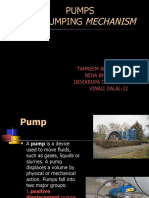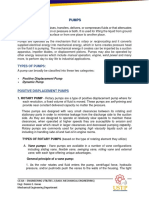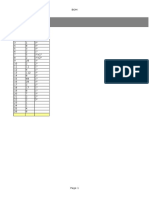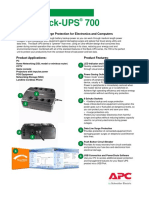0 ratings0% found this document useful (0 votes)
59 viewsAssignment Che239
Assignment Che239
Uploaded by
fatien zakariaThere are four main types of rotodynamic pumps described in the document: axial pumps (propeller pumps), centrifugal pumps (mixed flow and radial flow), and turbine pumps. Axial pumps develop pressure through the flow of liquid over propeller-like impeller blades and are used for applications like oil refineries. Centrifugal pumps, either mixed flow or radial flow, use an impeller to push liquid outwards, with radial pumps operating at higher pressures. Turbine pumps are mainly used for pumping water from deep underground sources and have low RPMs with high head.
Copyright:
© All Rights Reserved
Available Formats
Download as DOCX, PDF, TXT or read online from Scribd
Assignment Che239
Assignment Che239
Uploaded by
fatien zakaria0 ratings0% found this document useful (0 votes)
59 views2 pagesThere are four main types of rotodynamic pumps described in the document: axial pumps (propeller pumps), centrifugal pumps (mixed flow and radial flow), and turbine pumps. Axial pumps develop pressure through the flow of liquid over propeller-like impeller blades and are used for applications like oil refineries. Centrifugal pumps, either mixed flow or radial flow, use an impeller to push liquid outwards, with radial pumps operating at higher pressures. Turbine pumps are mainly used for pumping water from deep underground sources and have low RPMs with high head.
Original Description:
pump
Copyright
© © All Rights Reserved
Available Formats
DOCX, PDF, TXT or read online from Scribd
Share this document
Did you find this document useful?
Is this content inappropriate?
There are four main types of rotodynamic pumps described in the document: axial pumps (propeller pumps), centrifugal pumps (mixed flow and radial flow), and turbine pumps. Axial pumps develop pressure through the flow of liquid over propeller-like impeller blades and are used for applications like oil refineries. Centrifugal pumps, either mixed flow or radial flow, use an impeller to push liquid outwards, with radial pumps operating at higher pressures. Turbine pumps are mainly used for pumping water from deep underground sources and have low RPMs with high head.
Copyright:
© All Rights Reserved
Available Formats
Download as DOCX, PDF, TXT or read online from Scribd
Download as docx, pdf, or txt
0 ratings0% found this document useful (0 votes)
59 views2 pagesAssignment Che239
Assignment Che239
Uploaded by
fatien zakariaThere are four main types of rotodynamic pumps described in the document: axial pumps (propeller pumps), centrifugal pumps (mixed flow and radial flow), and turbine pumps. Axial pumps develop pressure through the flow of liquid over propeller-like impeller blades and are used for applications like oil refineries. Centrifugal pumps, either mixed flow or radial flow, use an impeller to push liquid outwards, with radial pumps operating at higher pressures. Turbine pumps are mainly used for pumping water from deep underground sources and have low RPMs with high head.
Copyright:
© All Rights Reserved
Available Formats
Download as DOCX, PDF, TXT or read online from Scribd
Download as docx, pdf, or txt
You are on page 1of 2
ROTODYNAMIC PUMP
PUMP FUNCTION APPLICATION
An axial flow pump has a propeller- Oil refineries, power
AXIAL PUMP (PROPELLER) type of impeller running in a casing. plants
The pressure in an axial flow pump Building services
is developed by the flow of liquid Chemical and Process
over the blades of impeller. It allows Industries
the fluid to enter the impeller axially
Industries and Water
and discharge the fluid nearly
axially. The propeller of an AFP is engineering
driven by a motor.
Mixed flow centrifugal In power plants, they are
CENTIFUGAL PUMP (MIXED FLOW) pumps borrow characteristics from used for pumping water
both radial flow and axial flow from a reservoir, river,
pumps. As liquid flows through the lake or sea for cooling the
impeller of a mixed flow pump, the main condenser
impeller blades push the liquid out
In the chemical industry,
away from the pump shaft and to
they are used for
the pump suction at an angle greater
circulation of large
than 90 degrees.
masses of liquid, such as
in evaporators and
crystallizers
In sewage treatment, an
axial flow pump is often
used for internal mixed
liquor recirculation
In agriculture and
fisheries very large
horsepower axial flow
pumps are used to lift
water for irrigation and
drainage
CENTRIFUGAL PUMP (RADIAL) Radial-flow pumps operate at higher Used for hydraulic
pressures and lower flow rates than purposes
axial and mixed-flow pumps. Pumping of water in
building
In the medical industry,
pump is used for
biochemical processes
and in biomimicry.
A turbine pump that is mainly used Turbine water pumps are
TURBINE PUMP to pump water from deep wells or used for various
other underground and man made applications, such as
bodes of water to water distribution pumping water for
systems. irrigation, firefighting,
hydroelectricity, and
treatment of waste water
The major advantage of
the turbine water pump is
its low revolutions per
minute, or RPM, with a
high and constant head.
This feature enables the
use of these pumps for
the continuous pumping
of water from deep wells.
You might also like
- BAHIR DAR UNIVERSITY - Design of Centrifugal Pump AbDocument30 pagesBAHIR DAR UNIVERSITY - Design of Centrifugal Pump AbADEFRIS BELACHEWNo ratings yet
- 1 Types: 1.1 Positive Displacement PumpDocument15 pages1 Types: 1.1 Positive Displacement Pumpwasim92khanNo ratings yet
- Mechanical Design ChecklistDocument2 pagesMechanical Design Checklisteng_bilalNo ratings yet
- Natsteel MeshDocument16 pagesNatsteel Meshsyafiqabang0% (1)
- Chapter 6 PDFDocument7 pagesChapter 6 PDFCalvin KewNo ratings yet
- MAchine 3Document3 pagesMAchine 3Cantera, Cris Bryan E.No ratings yet
- PUMPSDocument3 pagesPUMPSJohn Carl Ambrocio CorpuzNo ratings yet
- Name Picture Description: Centrifugal PumpsDocument17 pagesName Picture Description: Centrifugal PumpsJulius BoitizonNo ratings yet
- Research 1Document6 pagesResearch 1Mary Ann CestinaNo ratings yet
- Adobe Scan Apr 01, 2024Document25 pagesAdobe Scan Apr 01, 2024NimeshNo ratings yet
- AME-Chap16-Water Pumping EquipmentDocument10 pagesAME-Chap16-Water Pumping EquipmentJordan YapNo ratings yet
- Water PumpingDocument39 pagesWater PumpingArman RiveraNo ratings yet
- Active Learning Process: Branch: Computer EngineeringDocument29 pagesActive Learning Process: Branch: Computer EngineeringAjit KumarNo ratings yet
- Performance Analysis of Reciprocating PumpDocument8 pagesPerformance Analysis of Reciprocating PumpMohamed HassanNo ratings yet
- Centrifugal Pumps: Turbo Machines Amit Pathania Roll No:09309 Mechanical EngineeringDocument4 pagesCentrifugal Pumps: Turbo Machines Amit Pathania Roll No:09309 Mechanical EngineeringAmit PathaniaNo ratings yet
- Useful Information On Centrifugal Pumps: 3wiseDocument1 pageUseful Information On Centrifugal Pumps: 3wisehumaNo ratings yet
- Master 36 Module 3 Main Impeller TypesDocument9 pagesMaster 36 Module 3 Main Impeller Typesnaseer lateeNo ratings yet
- PumpDocument4 pagesPumpsaiemNo ratings yet
- FINAL BOOK OrgDocument46 pagesFINAL BOOK Orgmohanchukka343No ratings yet
- In-Plant Pump Station PDFDocument9 pagesIn-Plant Pump Station PDFAndrés BahamondeNo ratings yet
- Turbomachinery: Centrifugal Pumps Are A Sub-Class of Dynamic Axisymmetric WorkDocument4 pagesTurbomachinery: Centrifugal Pumps Are A Sub-Class of Dynamic Axisymmetric WorkOscar Ballarta100% (2)
- Self Priming Centrifugal PumpsDocument9 pagesSelf Priming Centrifugal Pumpsmember1000No ratings yet
- Introduction To PumpsDocument10 pagesIntroduction To Pumpsalina.vacoeaNo ratings yet
- Pumps Sin VideosDocument40 pagesPumps Sin Videoslaura velasco100% (1)
- National University of Engineering Language Department Special Test English I - Mechanical EngineeringDocument5 pagesNational University of Engineering Language Department Special Test English I - Mechanical Engineeringdixon aranaNo ratings yet
- PumpDocument37 pagesPumpmarzuqj8No ratings yet
- PUMPSDocument7 pagesPUMPSmohammed yusufNo ratings yet
- PUMPS ReviewerDocument63 pagesPUMPS ReviewerMark Santos100% (1)
- NOTES 9 (2023) TurbomachineryDocument22 pagesNOTES 9 (2023) TurbomachineryVinn GTNo ratings yet
- Waste WaterDocument18 pagesWaste WaterJelou SibiNo ratings yet
- Typical Application of Centrifugal PumpsDocument23 pagesTypical Application of Centrifugal PumpsHaryadiNo ratings yet
- Difference Between Watering and Dewatering Pumps: by Manoj YadavDocument6 pagesDifference Between Watering and Dewatering Pumps: by Manoj YadavManoj YadavNo ratings yet
- All ChaptersDocument38 pagesAll ChaptersMalliKarjun ReddyNo ratings yet
- Articulo en Ingles AutomatizacionDocument4 pagesArticulo en Ingles AutomatizacionJuan Mateo Grajales RubianoNo ratings yet
- DJJ50203 Topic 5 PumpsDocument66 pagesDJJ50203 Topic 5 PumpsHafiy QursyeiniNo ratings yet
- Group 4 Hydraulics 1Document14 pagesGroup 4 Hydraulics 1STOCK MSOWOYANo ratings yet
- 5.5 Thing Power Plant Need To Know About PumpsDocument4 pages5.5 Thing Power Plant Need To Know About Pumpsfirdausshukri14No ratings yet
- Pumps N MechDocument17 pagesPumps N MechmeerhatNo ratings yet
- GROUP 4 RAM PUMPDocument11 pagesGROUP 4 RAM PUMPmichelallanbicoyNo ratings yet
- Pump & Pump Piping PresentationDocument55 pagesPump & Pump Piping PresentationEduard Gonzalo Rojas Cervantes100% (1)
- Lab 2 ..Document4 pagesLab 2 ..faizkhanbro12No ratings yet
- Chapter Four: Hydraulic Machines 4. Hydraulic Machines: Hydraulics-II Lecture Notes June 1, 2014Document15 pagesChapter Four: Hydraulic Machines 4. Hydraulic Machines: Hydraulics-II Lecture Notes June 1, 2014Ermiyas AlhegnNo ratings yet
- Pumps (In General) : Group 4Document14 pagesPumps (In General) : Group 4STOCK MSOWOYANo ratings yet
- Irrigation PumpsDocument36 pagesIrrigation PumpsLopez Larry John P.No ratings yet
- Dynex Pump Application GuideDocument12 pagesDynex Pump Application GuideAlexisAlejandroSandovalFloresNo ratings yet
- Module 3 Basic Principles and Pump Types Main Impeller Types Master PDFDocument9 pagesModule 3 Basic Principles and Pump Types Main Impeller Types Master PDFadel allamNo ratings yet
- PumpDocument36 pagesPumpHanif Hasan ZakiNo ratings yet
- Pumps An Overview-KulnajiDocument97 pagesPumps An Overview-KulnajiSakthi MuruganNo ratings yet
- Pumping Equipment in Phosphate Fertilizer Processes A10311 enDocument4 pagesPumping Equipment in Phosphate Fertilizer Processes A10311 enSandy ZhangNo ratings yet
- PUMP SYSTEM (UPDATED)Document19 pagesPUMP SYSTEM (UPDATED)rayman.artheagrace.11stema.znhsNo ratings yet
- Centrifugal Pump Vs Reciprocating PumpDocument1 pageCentrifugal Pump Vs Reciprocating PumpGadal 3000No ratings yet
- Centrifugal Pump Vs Reciprocating Pump 1619353778Document1 pageCentrifugal Pump Vs Reciprocating Pump 16193537784A28Sparsh JainNo ratings yet
- Research On Method For Modelling and Control of Feedwater Piping System Based On Internal Characteristics of The Feedwater PumpDocument7 pagesResearch On Method For Modelling and Control of Feedwater Piping System Based On Internal Characteristics of The Feedwater Pumpshayanniaki98No ratings yet
- Self Priming PumpsDocument4 pagesSelf Priming PumpsMUHAMMAD AWAIS UR REHMANNo ratings yet
- Main Impeller Types: Basic Principles and Types of PumpsDocument9 pagesMain Impeller Types: Basic Principles and Types of PumpsThinagaran N ManiamNo ratings yet
- Pump Techmolog. Chap 1-2019Document95 pagesPump Techmolog. Chap 1-2019Samer SawanNo ratings yet
- Irrigation Water PumpsDocument12 pagesIrrigation Water PumpstowdamoonNo ratings yet
- Lecture 5 - Pumps PDFDocument8 pagesLecture 5 - Pumps PDFKyle SarmientoNo ratings yet
- Pump & Pump Piping PresentationDocument55 pagesPump & Pump Piping PresentationNaveen Namani100% (9)
- Positive Displacement Pump Pressure or Head: Activity No. 3 Physical Study of Pump UnitDocument9 pagesPositive Displacement Pump Pressure or Head: Activity No. 3 Physical Study of Pump UnitMerie Ann Aumentado CallejaNo ratings yet
- How to Select the Right Centrifugal Pump: A Brief Survey of Centrifugal Pump Selection Best PracticesFrom EverandHow to Select the Right Centrifugal Pump: A Brief Survey of Centrifugal Pump Selection Best PracticesRating: 5 out of 5 stars5/5 (1)
- How Reverse Osmosis Works: A Look at Industrial ROFrom EverandHow Reverse Osmosis Works: A Look at Industrial RORating: 2.5 out of 5 stars2.5/5 (2)
- Project CharterDocument9 pagesProject Charterfatien zakariaNo ratings yet
- Result and DiscussionDocument3 pagesResult and Discussionfatien zakariaNo ratings yet
- Environmental Audit SlideDocument10 pagesEnvironmental Audit Slidefatien zakariaNo ratings yet
- Presentation 1Document9 pagesPresentation 1fatien zakariaNo ratings yet
- Felda Iffco SDN BHDDocument14 pagesFelda Iffco SDN BHDfatien zakariaNo ratings yet
- Distillation Chapter 2Document35 pagesDistillation Chapter 2fatien zakaria100% (1)
- Distillation SolvedDocument14 pagesDistillation Solvedhoneylet tayactacNo ratings yet
- OLEODocument9 pagesOLEOfatien zakariaNo ratings yet
- Che 246 - Mass Transfer and Unit Operations Tutorial-Chapter 2 (Distillation)Document5 pagesChe 246 - Mass Transfer and Unit Operations Tutorial-Chapter 2 (Distillation)fatien zakariaNo ratings yet
- Colour Mixture Chart: 17 DISEMBER 2017Document4 pagesColour Mixture Chart: 17 DISEMBER 2017fatien zakariaNo ratings yet
- PT. Daido Metal Indonesia Company ProfileDocument9 pagesPT. Daido Metal Indonesia Company ProfileAris Gunawan RaharjaNo ratings yet
- Muhammad Nasir: ObjectiveDocument3 pagesMuhammad Nasir: ObjectiveMuhammad NasirNo ratings yet
- Seminar PPT On Green ConcreteDocument16 pagesSeminar PPT On Green ConcreteSandeep Meena75% (8)
- LM3940IS 3.3 National SemiconductorDocument12 pagesLM3940IS 3.3 National SemiconductorMiguel De Dios SinovasNo ratings yet
- Lesson 1 MSTDocument38 pagesLesson 1 MSTColin CagampangNo ratings yet
- Farooq Ahmed: Instructor Economics Virtual University of PakistanDocument14 pagesFarooq Ahmed: Instructor Economics Virtual University of PakistanaimalNo ratings yet
- Sp01954 Egc Alarm List Rev5Document11 pagesSp01954 Egc Alarm List Rev5Tomislav BanićNo ratings yet
- Sello Mecánico PDFDocument3 pagesSello Mecánico PDFatenciajNo ratings yet
- 2017 Tech & Facts Report Spark en Print PDF 1Document46 pages2017 Tech & Facts Report Spark en Print PDF 1nicholas_j_vaughanNo ratings yet
- UFC Design of Building To Resist Progressive Collapse PDFDocument245 pagesUFC Design of Building To Resist Progressive Collapse PDFHCStepNo ratings yet
- Unit Three - II - Process SelectionDocument12 pagesUnit Three - II - Process SelectionFuadNo ratings yet
- Embankment Side Slope Selection in BagaladeshDocument1 pageEmbankment Side Slope Selection in BagaladeshRajesh KhadkaNo ratings yet
- Mabuchi Motor RS-385SADocument1 pageMabuchi Motor RS-385SAVicente E. Marin L.No ratings yet
- Fortress Timber & Metal SDS Screws 2017 WebDocument36 pagesFortress Timber & Metal SDS Screws 2017 WebGabriel MacedoNo ratings yet
- Bom / Mto For Propane/Butane Buffer Bullet Piping For BPCL.: Mark QTY SizeDocument3 pagesBom / Mto For Propane/Butane Buffer Bullet Piping For BPCL.: Mark QTY SizetesNo ratings yet
- 5 Site Layout and DevelopmentDocument35 pages5 Site Layout and Developmentwai hang chooNo ratings yet
- Supplier PPAP Manual 1Document23 pagesSupplier PPAP Manual 1SagarPatelNo ratings yet
- APC Back-UPS 700 ManualDocument2 pagesAPC Back-UPS 700 Manualİlteriş EroğluNo ratings yet
- P100 Liste 2016Document9 pagesP100 Liste 2016Bertrand Soppo YokiNo ratings yet
- QEVDocument6 pagesQEVsamikatnetNo ratings yet
- Uses and Misuses of Natural ResourcesDocument4 pagesUses and Misuses of Natural ResourcesAMIN BUHARI ABDUL KHADERNo ratings yet
- Masterdrives Manual Retificador (Ing) PDFDocument224 pagesMasterdrives Manual Retificador (Ing) PDFBatchmanNo ratings yet
- Melbourne School of Design Case StudyDocument11 pagesMelbourne School of Design Case Studydamandadino100% (1)
- PMRDocument1 pagePMRLinh Linh OvercomeboyNo ratings yet
- The Effects of Water Ingress Into Fire Fighting Elevator ShaftsDocument7 pagesThe Effects of Water Ingress Into Fire Fighting Elevator ShaftsrewmarineNo ratings yet
- tlb2 TraxDocument21 pagestlb2 Traxorlando100% (1)
- Id503 3f Library ModelDocument1 pageId503 3f Library ModeljaysonmalaaNo ratings yet


































































































